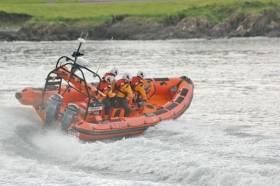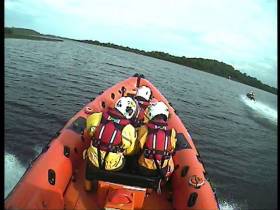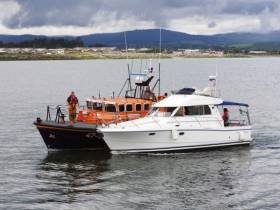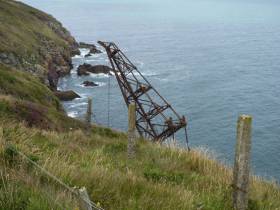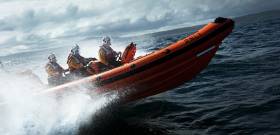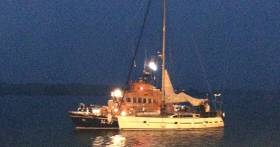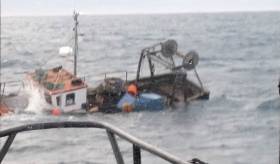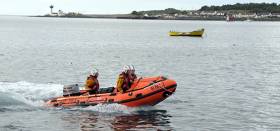Displaying items by tag: RNLI
#RNLI - Bangor RNLI assisted four people who got into difficulty on a broken-down motorboat on Belfast Lough on Monday evening (13 June).
The volunteer lifeboat crew launched at 10.25pm to rescue the 19ft motorboat just off the Cloghan Jetty.
The boat, with four people on board, had lost all power and was drifting in fog close to the shore.
Arriving at the scene, guided only by the light from a mobile phone, the crew of the relief Bangor lifeboat Tabby Cat took the motorboat under its control and returned it and its and crew safely to Carrickfergus Marina.
Speaking following the callout, Bangor RNLI helm Peter Semple said: :The crew and I are delighted that we were able to return these people to the safety of the marina. Although it was a calm night, it was dark, and Belfast Lough is not a great place to be if you can’t be seen.
"It is important to ensure that, if you lose all power you still have some way of being seen and making contact with the shore."
In other news from Bangor, the lifeboat station was recently visited by a man rescued a fortnight ago by one of its volunteers after he suffered a heart attack at sea.
Tim Bailie was on a weekend pleasure cruise between Carrickfergus and Bangor with his family at the end of May when he was taken ill.
But thanks to the quick action of helm Kyle Edwards and his crew, Bailie is still here to tell the tale in his own words, as per the video below:
#RNLI - Carrybridge RNLI attended three different incidents – one involving a fire – on Upper Lough Erne this past Saturday (11 June).
The inshore lifeboat and rescue wafer craft were initially tasked to a burning vessel at 6.08pm, two miles north of Belturbet. Both Belturbet and the NI Fire and Rescue Service were in attendance.
The four people onboard were safely removed from the boat by a passing vessel and brought to shore. The 25ft Bayliner later burnt itself out and sank into shallow waters close to the shoreline.
The volunteer crew were then tasked by Belfast Coastguard to a boat with engine problems 1.5 miles from Knockninny. The sports cabin cruiser and its four passengers and their dog were brought to safety at Knockninny Marina.
The third tasking saw Carrybridge RNLI going to a vessel that ran out fuel close to the Share Centre. The 22ft vessel and its passenger were brought to safety of the Share Centre Marina.
The lifeboat and rescue craft returned to station at 9.15pm.
Speaking following the callouts, Carrybridge RNLI helm Chris Cathcart said: "The crew of the burning vessel did the right thing by alerting the coastguard straight way when their vessel went on fire.
"They made sure they had their lifejackets on and evacuated their vessel to another passing vessel as soon as possible."
Cathcart also commended the crews of the further two vessels the lifeboat assisted for their quick thinking when they found themselves in danger.
"The importance of alerting the coastguard as soon as possible in all cases help saves lives and prevented the situation from developing into something more serious on all our callouts."
The busy evening for the volunteer crew was in the first weekend of the RNLI’s summer campaign #RespectTheWater that targets accidental drowning along Northern Ireland’s coastline and inland waterways.
Respect the Water urges the public to watch out for the key dangers that can catch people out in or near the water. The campaign which will run throughout the summer months aims to highlight the risk of accidental drowning when people are near the water’s edge while encouraging safer behaviour both in and around the water.
Wicklow Lifeboat Assists Five On Motor Cruiser
#RNLI - Wicklow RNLI's all-weather lifeboat launched to give assistance to an English motor cruiser at 12.20pm yesterday (Sunday 12 June).
The cruiser, with five people on board, was on passage from Dun Laoghaire to Pembroke when it developed mechanical problems four miles south of Wicklow Harbour.
Just 15 minutes later, the lifeboat, under the command of coxswain Nick Keogh, was alongside the drifting cruiser. A towline was established and the volunteer crew brought the cruiser back to Wicklow.
This was the second callout out of the week for the Wicklow RNLI crew. On Wednesday morning, the all-weather lifeboat launched to assist a French yacht with three people on board that had its propeller fouled by a rope.
The crew of the yacht managed to free the rope obstruction and the lifeboat stood by until the yacht was able to resume its passage south.
Next Friday 17 June, Wicklow RNLI will hold a lifejacket clinic at the lifeboat station from 11am to 4pm in conjunction with the Round Ireland Sailfest.
Anyone who owns a lifejacket is encouraged to bring it along for a free check. Advice will also be available with tips on how to choose, fit and maintain your lifejacket.
Man Dies While Diving Off Waterford Coast
#Diving - A man has died after getting into difficulty while diving off Ardmore in Co Waterford yesterday afternoon (Sunday 12 June).
Youghal RNLI's volunteer lifeboat crew were tasked to the incident between Goat Island and Ram Head near Ardmore, Co Waterford before 4.30pm.
On arrival they found a man in the water who they recovered onto the lifeboat, and immediately administered casualty care.
Working with Helvick Head RNLI, who were also on scene, the casualty was winched onto the Irish Coast Guard helicopter Rescue 117 and brought to Waterford University Hospital, where he was later pronounced dead, as the Irish Examiner reports.
A spokesperson for Helvick Head RNLI that a second diver who had been with the deceased had managed to swim to shore to raise the alarm, allowing for a swift emergency response.
Commenting on the callout, Youghal RNLI lifeboat operations manager Fergus Hopkins said: "This was a difficult callout for everyone concerned and our thoughts are with the family of the man who was taken from the water this afternoon."
Portaferry Lifeboat Rescues Three Lost In Thick Fog
#RNLI - Volunteers with Portaferry RNLI went to the aid of three men on board a 4m dory who had become lost in thick fog close to Ballyhornan on the Co Down coast on Thursday (9 June).
At the time of launch at 4.45pm, the weather was extremely foggy with very poor visibility, a Force 2 southerly wind and smooth sea conditions.
The three men had become lost in the worsening conditions and were unsure of their exact location. Rather than try and guess their location, they called emergency services for help, giving a rough position as somewhere between Sheepland Harbour and Guns Island, just off the Co Down coast.
Portaferry RNLI headed towards the men’s general location and at first passed the three men in the thick fog. On arrival at Sheepland Harbour, however, the lifeboat crew started to track back towards Guns Island.
By this time the men on board the lost vessel had called the coastguard once more to report that they had heard the engines of the lifeboat passing by, helping to pinpoint their location.
The lifeboat crew arrived on scene close to Guns Island at 5.15pm, attaching a tow rope and proceeding to tow the boat into Ballyhornan Bay, where the three men went safely ashore before the lifeboat returned to station.
Following on the rescue, Portaferry RNLI lifeboat operations manager Brian Bailie said: "The three men made the correct decision when they called for help.
"They had become lost and disorientated in thick fog and rather than try to blindly find their own way to shore, they called for help and remained in the area they last believed they were.
"This made our job a lot easier and I am delighted that our volunteer crew have helped bring these men safely to shore."
Five RNLI Lifeboats Involved in Search for Missing Microlight Aircraft off Northern Ireland Coast
Five RNLI lifeboats were launched last night from Larne and Red Bay in Northern Ireland and Portpatrick in Scotland to take part in an extensive search for a missing microlight aircraft. The craft is understood to have two people onboard when it was reported missing off the Northern Ireland coastline.
The launch was requested by the coastguard when the aircraft was reported overdue at 8.30pm and a major search operation was put in place.
Joining the five RNLI lifeboats in the major search were the Irish Coast Guard Helicopter Rescue 116 along with a rescue helicopter from Prestwick and local coastguard teams.
Search conditions were described as extremely challenging as visibility was poor due to thick fog. Larne RNLI launched their all-weather lifeboat and D class lifeboat, Red Bay RNLI launched their Atlantic 85 and all-weather lifeboat along with the all-weather lifeboat from Portpatrick. The lifeboats between them searched a huge area off the Northern Ireland coastline before standing down the search after 4am. It is expected that the search will resume again this morning; however weather conditions remain poor with heavy fog still present.
UK Coasguard adds
At about 8.30pm yesterday (Thursday 9 June) Distress and Diversion (based at Swanwick) notified the UK Coastguard that a small microlight aircraft with two persons on board had been reported overdue.
The microlight was transiting the Northern Ireland coastline when it went missing and an extensive search is being carried out in the area.
Last night and in the early hours of this morning, the UK Coastguard search and rescue helicopter based at Prestwick, the Irish Coastguard helicopter based at Dublin, Ballycastle, Coleraine, Stranraer, Portpatrick, Larne and Campbelltown Coastguard Rescue Teams, Larne RNLI inshore and all weather lifeboats, Red Bay inshore and all weather lifeboats and Portpatrick RNLI all weather lifeboats, were all involved in the search.
The search was suspended due to poor visibility as a result of fog at 3.00am today (Friday 10 June). The teams and rescue units are waiting for the visibility to improve before they resume the search.
The Northern Ireland North West Mountain Rescue Team will also be joining the search today.
Ryan Gray, Senior Maritime Operations Officer at the UK Coastguard said: ‘UK Coastguard has also issued a Mayday relay broadcast in the area and several merchant shipping vessels have responded and are keeping a lookout for this aircraft. We may send further resources as the search widens.’
The Northern Ireland Police and Police Scotland have also been informed.
A further update will be provided when the search resumes.
The Courtmacsherry RNLI All Weather Lifeboat was called out at 9.05 pm tonight to go to the aid of a 35–ft French yacht that got into difficulty one mile off the Old Head of Kinsale in West Cork.
The Courtmacsherry Lifeboat under Coxswain Sean O'Farrell and a crew of six launched immediately and reached the vessel at 9.26pm and succeeded in quickly getting a tow rope on board, which had lost power and was drifting. With a crew of three on board, the yacht was taken immediately under tow by the lifeboat and arrived back safely to Courtmacsherry pier at 10.35pm.
The yacht was under passage from France when they encountered difficulties just off the Old Head of Kinsale and sent out a Mayday distress call.
Courtmacsherry RNLI Voluntary Lifeboat Operations Manager Brian O Dwyer said " the quick response of the Crew tonight, with some in the Lifeboat House attending a Crew and Fundraising meeting to organise the Stations Open Day on Sun June 26th, was testament to their commitment to lifesaving and it was great to have the casualty in the safe surround of Courtmacsherry Pier pontoon just over 90 minutes from receiving the Callout from Valentia Coastguard".
Castletownbere RNLI rescued two fishermen from a sinking vessel in the early hours of this morning. The volunteer crew was requested to launch their all-weather lifeboat at 4.45am to go to the assistance of a fishing vessel which was reported sinking 11 miles south west of Dursey Island on the Beara peninsula.
The Castletownbere lifeboat under Coxswain Brian O’Driscoll and with six crew members onboard was launched minutes later at 4.55am.
Weather conditions at the time were described as good with a Force three to four wind and good visibility.
The naval vessel LE Orla and the Irish Coast Guard’s Rescue 115 helicopter were also tasked.
The lifeboat was on scene at 5.50am where the crew found two fishermen in a life raft.
Both men were taken aboard the lifeboat and were reported to be safe and well.
The lifeboat arrived back to Castletownbere at approximately 8am this morning.
Speaking following the call out, Paul Stevens, Castletownbere RNLI Volunteer Lifeboat Press Officer said: ‘Fortunately the weather conditions were favourable early this morning and we were able to quickly transfer the two fishermen into the safety of the lifeboat. Both are safe and well. They did the right thing this morning and raised the alarm when they got into difficulty.
‘This morning’s call out came as the RNLI prepared to launch its Respect the Water campaign today,
The RNLI today launches its annual national drowning prevention campaign, Respect the Water, and this year the charity is warning the public to watch out for key dangers that can catch people out in or near water.
The campaign which will run throughout the summer months comes a week after the RNLI, the Coast Guard and Irish Water Safety issued a joint statement advising caution to those engaged in recreational activities in or near water during hot weather as the number of call outs rose sharply.
Respect the Water aims to highlight the risk of accidental drowning when people are near the coastline by encouraging safer behaviour both in and around the water. The campaign is primarily aimed at males aged between 16 and 39 but the same advice is relevant for anyone visiting the coast.
Coastal fatality figures released by the RNLI show that an average of 23 people die through accidental drowning around the coast of the Republic of Ireland each year.
The RNLI has joined with Irish Water Safety and the School of Psychology at the National University of Ireland, Galway, to develop a drowning fatalities database. The work of the group has found that between 2010 and 2013, 70 lives were lost around the coast of the Republic of Ireland through accidental drowning.
The RNLI is warning of the key dangers that can lead to accidental drowning - cold water, unexpected entry into the water, and rip currents and waves.
The campaign will reinforce the key message ‘Treat water with respect, not everyone can be saved’ on a range of channels throughout the Summer. These include a poster showing dramatic imagery of the hand of a drowning person reaching for a lifebuoy and hard-hitting cinema advertisements showing the unpredictability of the water and the dangers of cold water shock.
Speaking as Respect the Water was launched, Joe Moore, RNLI Community Incident Reduction Manager said: ‘We want everyone to enjoy the water. However, it is powerful and unpredictable and people need to treat it with respect. Each year RNLI lifeboat crews rescue hundreds of people around Ireland but sadly, not everyone can be saved. The real tragedy is that many of these deaths could have been prevented.
‘Cold water is a real killer, People often don’t realise how cold our waters can be – even in summer months the water temperature rarely exceeds 12 degrees, which is cold enough to trigger cold water shock. If you enter the water suddenly at that temperature, you’ll start gasping uncontrollably, which can draw water into your lungs and cause drowning. The coldness also numbs you, leaving you helpless – unable to swim or shout for help.
‘The fact that over half of the people who die around our coast each year never planned to enter the water serves as a warning to us all to stay away from cliff edges, particularly where there is slippery, unstable, unstable or uneven ground; stick to marked paths and keep an eye on the water – watch out for unexpected waves which can catch you out and sweep you into the water.
‘If you’re planning to enter the water be aware that, even if it looks calm on the surface, there can be strong rip currents beneath the surface, which can quickly drag you out to sea. The sea is powerful and can catch out even the strongest and most experienced swimmers.’
The charity is asking people to visit RNLI.org/RespectTheWater where they will find information on coastal hazards, how to keep themselves safe, and what to do should they someone else end up in trouble in the water. On social media search #RepectTheWater.
Volunteer lifeboat crew at Larne RNLI responded to a launch request from the UK Coastguard yesterday evening to help search for three overdue divers near Blackhead Lighthouse.
The initial alarm was raised at 5.30pm to report three divers who were 40 minutes overdue. Larne All-weather lifeboat launched followed by Larne inshore lifeboat and the crews were quickly on scene in the Blackhead Area to commence the search. The major multiagency search was coordinated by the coastguard and included Bangor RNLI, the Irish Coast Guard helicopter Rescue 116, four shipping vessels, two boats from Whitehead Yacht club and Larne, Portmuck and Bangor coastguard teams.
The weather conditions of calm seas with thick banks of rolling fog caused poor visibility and challenging search conditions.
Larne RNLI inshore lifeboat located the three divers at 6.50pm on a cliff face north of The Gobbins. The divers were recovered into the lifeboat and did not require medical assistance however they were fatigued, hungry and thirsty. Larne All-weather lifeboat then took the divers onboard and transferred them safely back to Belfast Coastal Operations Centre in Bangor.
Larne RNLI Operations Manager Allan Dorman said 'Conditions were very challenging with visibility down to about fifteen metres. The divers did the right thing and stayed together. We were fearful as time passed and our lifeboat crews were still searching the area with no sightings but thankfully the tide took them north and to nearby rocks. They were exhausted when they were finally located and recovered onto the inshore lifeboat. We are extremely thankful that the callout ended well with everyone accounted for and safely recovered. Our thanks to everyone involved in the search.’
UK Coastguard adds:
Three divers found safe after extensive UK Coastguard search and rescue operation
UK Coastguard coordinated the search and rescue operation for three divers this afternoon who were located by the Larne RNLI inshore lifeboat after nearly two hours in the water.
At 5.30pm today (8 June) UK Coastguard received a call from the coxswain of a RHIB (rigid hulled inflatable boat) dive boat reporting that three divers were 20 minutes overdue from their dive in the area of Blackhead, Belfast Lough.
A Mayday emergency broadcast was issued to alert all shipping vessels in the area and the Ballycastle, Bangor, Larne and Portmuck Coastguard Rescue Teams, the Irish Coastguard helicopter, Bangor RNLI inshore lifeboat and Larne RNLI all weather and inshore lifeboats carried out an extensive search. Four commercial vessels, two fishing boats, a yacht and four RHIBs from the Whitehead Yacht Club responded to the Mayday broadcast and joined the search efforts.
The crew of the Larne RNLI inshore lifeboat spotted the three divers nearly three miles from their original dive location. They were safely put onto the boat and taken to the Bangor Marina where they were met and given safety advice by the Bangor Coastguard Rescue Team. They required no medical treatment.
Ryan Gray, Senior Maritime Operations Officer for the UK Coastguard said: ‘The coxswain of the RHIB dive boat did exactly the right thing calling the UK Coastguard when it became apparent that the divers were overdue. Although we had very heavy fog in the area which reduced visibility, these divers were extremely experienced and had an emergency plan in place when they found themselves in difficulty. It was a very challenging search operation given the weather conditions, however, the divers’ professionalism and the fact that they stayed calm and stuck together, meant that we were able to locate them quickly. They had all the right equipment to cope with this situation and we are extremely glad that they were found safe and well.
‘We would like to extend a massive thank you to all those who reacted quickly to the Mayday broadcast that was issued. It was truly a coordinated effort and everyone did a fantastic job to bring these divers home safely.’
Mr Allan Dorman Larne, RNLI Lifeboat Operations Manager said: ‘Conditions were very challenging with visibility down to about fifteen metres. The divers did the right thing and stayed together. We were fearful as time passed and our lifeboat crews were still searching the area with no sightings but thankfully the tide took them north and to nearby rocks. They were exhausted when they were finally located and recovered onto the inshore lifeboat. We are extremely thankful that the callout ended well with everyone accounted for and safely recovered. Our thanks to everyone involved in the search.’


























